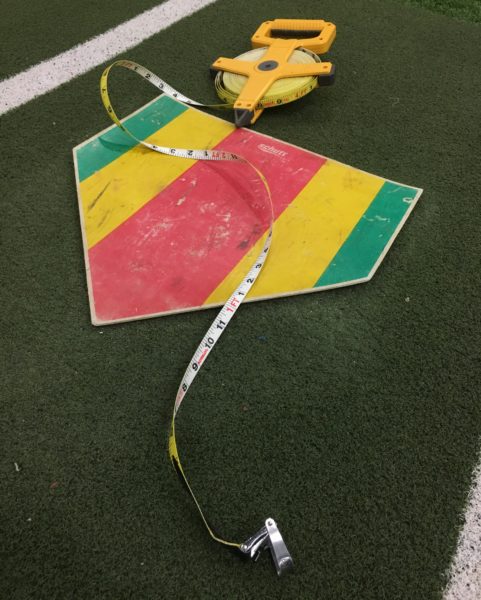What distance for fastpitch softball pitching in USSSA, NSA, PONY, NFHS, & ASA
Pitching length from home plate back-end point (closest to catcher) to the front of pitching rubber can vary by local league or association slightly, but for the most part, the official distances are listed below.
| Age | Pitching Distance | Softball Size |
|---|---|---|
| 8u | 30′ (Feet) | 11″ (Inches) |
| 10u | 35′ | 11″ |
| 12u | 40′ | 12″ |
| 14u | 43′ | 12″ |
| 16u | 43′ | 12″ |
| 18u | 43′ | 12″ |
What is the distance from home plate to the front of the pitching mound in fastpitch Softball? The pitching rubber is the white slab centered in the 16 foot radius circle that is 24 inches long by 6 inches wide. In summary: Pitching distance for 10U is 35 ft., for 12U it’s 40 ft., and for 13U and up it’s 43 ft.
Interestingly enough, in the 1996 and the 2000 Summer Olympics, the fastpitch softball pitching distance from the rubber to the apex of home plate was 40 feet! Similarly, back around 2011, Pony/ASA softball allowed pitching rubber to the plate measurements of 40 feet all the way up through 18u, but then it changed to 43 feet. I’m glad too (for all the pitchers) that this change was made because composite softball bats are ‘jacked’ nowadays, and considering that when a pitcher strides fully it puts her at the end of the circle — basically right on top of the batter, with very little time to react!
One situation that nullifies this distance-to-age as an exact science is when you have a middle school girls’ softball team that consists of a 12-year-old and 13-year-old pitcher (7th and 8th-grade girls) on the same team. The 12-year-old will be accustom to throwing at 40ft with her travel and recreational squad, but all the sudden is expected to throw in a game at 43 feet. The 13-year-old pitcher will be used to the increased distance already. When I give pitching lessons to pitchers at the 12u age, I make sure to work in the extra 3 feet occasionally, so they can start to get used to it before the ‘rubber hits the road’.

Why is it important how far pitchers throw at 8u, 10u, 12u & 14u?
At the ages of 12 years old and 14 years old, besides significant changes that are happening due to female adolescence, there are a few major changes in softball:
- The distance continually increases for pitchers from the pitching mound’s rubber to home plate, from 35 feet to 40 feet to 43 feet, as the strength of the girl grows and the distance increases to add additional reaction time.
- The softball size increases from 11 inches to 12 inches, increasing dimension and weight. Good news… also adding more mass and more seams, which true to physics increases the velocity and late-breaking spin potential!
- Not to mention, the level of competition gets a lot more serious. I’ve even seen 14-and-under travel ball teams become the pinnacle of all ages (occasionally) due to the fact that the ones that are in it at this age are in it to win it, chasing scholarships! (and not yet distracted by some of the items the 16u and 18u players are like boyfriends, driving, going to the beach for the summer, getting jobs, etc., which can reduce the number of girls playing and the intensity of the competition.)
A Bigger softball
An excellent way to introduce a girl to the bigger 12″ softball is to make sure she throws mechanically sound over hand first with flicks and gradually increasing the distance throwing before you start the underhand flicks, and you start to work it to increase your distance with the full windmill rotation.
The Distance increases
Strength training, especially isometrics and core workouts, can really help as the pitching distance from the circle to the plate increases. The female athlete will want to keep a balanced and not be one-sided strong from repetitious right-handed or left-handed pitching and hitting. Along with strength training, an excellent way to develop the pitcher to transition seamlessly to 40 feet and to 43 feet is to make sure her wrist is strong, and she can snap the ball and stay behind the ball so that she does not roll her wrist or start bowling it. Useful drills to work on for this are walk-through drills and progressive long toss. Also, the following drill from Amanda Scarborough also works really well to really start to utilize the leg power as the distance increases.
